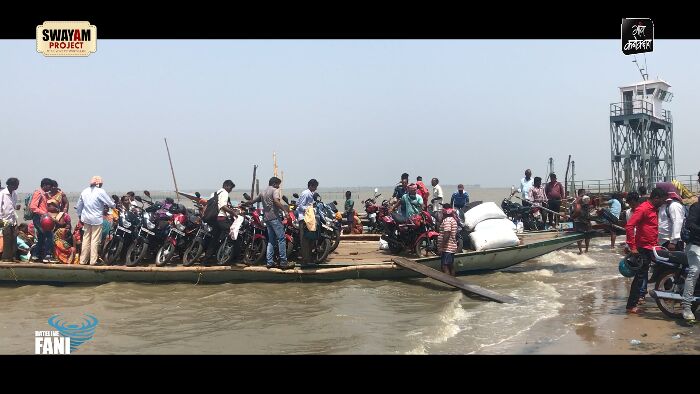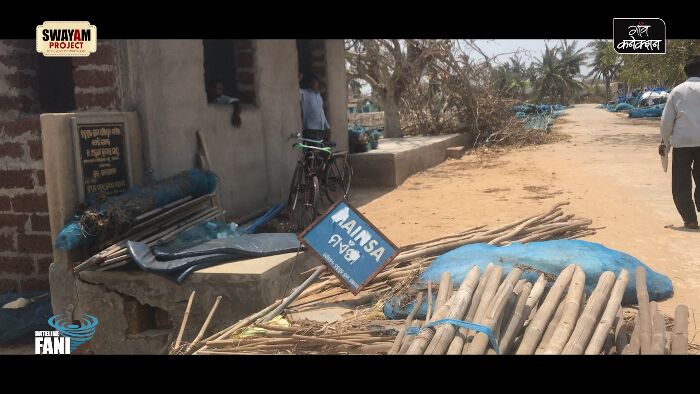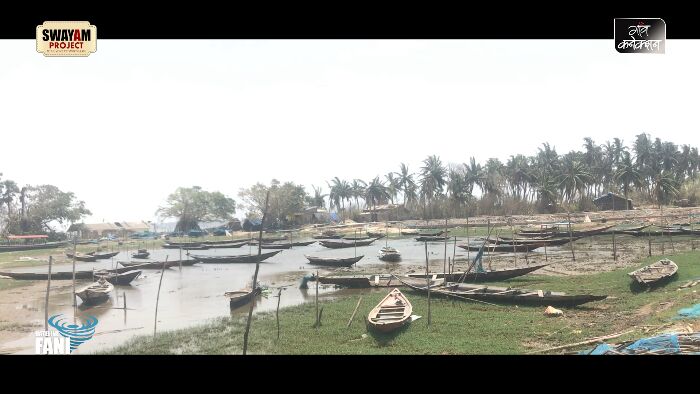Far away on a tiny island inside a massive lake, lives a woman who thinks she is eighty and a boy who knows he is 13. Their village lost everything this summer — the boats are gone. The nets are gone. The houses are gone.
Fisher Kamoli Behra lives in the water-locked Behrampur village of 1,500 fishers inside the 1,100-sqkm Chilika Lake. She doesn’t remember her exact age, but she believes she is more than 80 years old. She does remember the devastation of past natural disasters – and how they were no match to this time.
“I have braved several storms. Heavy rains and winds don’t scare me. But what I witnessed on May 3 morning has shaken me beyond words,” said Kamoli, who lives in the Bahrampur village and who spent the night of May 2 and May 3 at a cyclone shelter about half a kilometre from her home, on the island itself.
But it’s not easy to get to her. Not for relief officials, not for the visiting reporter from the faraway big city on a recent afternoon.

More than two weeks after Cyclone Fani ravaged Odisha’s coastline on May 3 and killed 64 people, a Gaon Connection reporter travelled by boat to remote villages perched far away from the headlines. The journey – and the desperate lives of the villagers in Odisha’s remote backyard are powerful symbols of how the state’s coastal residents so often bear the brunt of nature, losing everything and then trying to rebuild yet again.
The journey to the village starts from Puri town, also devastated by the cyclone. All along the picturesque landscape, one witnesses naked, uprooted trees lying along the road. Like a giant lawn mower, Cyclone Fani chopped trees and sheared everything in its way.
Suddenly the landscape changes from open barren fields, roofless houses and collapsed mud houses to a series of large water bodies — aquaculture ponds for shrimp farming. These ponds, numbering in hundreds, are an indication that Chilika lake, Asia’s largest brackish water lake, is nearby. Shrimp farming is an important source of livelihood of local people, so much so that violent fights often erupt over ownership and usage of these ponds.
All along, villagers are seen queuing up at mobile water tankers sent by the government to supply drinking water to Fani-affected people. It is hot. Villagers, including children, have no choice, but to wait their turn. Extra hands mean additional water for the family, as no one knows when the water tanker would arrive next. After the immediate damage caused by the cyclone, access to safe drinking water remains a big challenge as water supply schemes have fractured and several water sources have gone saline.
And then, one reaches a beach where the boat journey to the remote village is to begin. The beach is dotted with crabs.
The land’s end
This is Satpada — the land’s end. This is where one will get a boat to travel to the two island villages of Bahrampur and Moisa, that are located inside the Chilika and were badly affected by Fani. On any regular day, Satpada is bustling with tourists and boatmen. Predictably so, as Chilika lake is a 1,100 square kilometres brackish water lagoon spread across the Puri, Khurda and Ganjam districts of Odisha. Because of its rich biodiversity, Chilika is a Ramsar site, which is a wetland of international importance. It is expected to join the UNESCO World Heritage list as well.
But these days, the bustling beach of Satpada is deserted. Most boats are either broken or lost. The trauma and fear after the cyclone shall take time to wear off. The boatman charges Rs 3 per person for the boat ride from Satpada to Moisa, a village inside Chilika.

Far away, deep inside the Chilika, one can see an island where the Bahrampur and Moisa villages are located. The waters of Chilika are calm. Who would have thought that two weeks ago, the lake’s water had churned and destroyed a large number of boats, dragging them into the unknown, few kilometres away into the Bay of Bengal.
Boatman Guru agrees to take us to Bahrampur, a boat ride of about 15-20 minutes. He slides a wooden plank down the boat to climb up his large boat that transports not only people, but also two-wheelers. Guru makes three to four attempts before the boat comes to life. He has wrapped the motor with a thick rope and pulls the rope to start the motor. The motor starts with a deafening sound. With a long oar, Guru expertly manoeuvres the boat deep inside the brackish water lagoon. During the tourist season, he says, he takes tourists to spot dolphins — the Chilika lagoon is home to the endangered Irrawaddy Dolphins.
As the boat cuts through the water of Chilika, one can taste its brackish water, splashing on the face. On a hot summer afternoon, it feels pleasant. Slowly the island inside Chilika starts to appear bigger and bigger.
The boat reaches the island inside Chilika. People waiting to get onto the boat inform the reporter that the place is Moisa village. Bahrampur village – where the old woman lives — is another half-a-kilometer walk away. The path is all broken after the cyclone. Broken boats and torn fishing nets are heaped along the way.
“Our fathers and forefathers, all fishers, have lived on this island,” says Jaggubandh Jena, 35, a fisher from Behrampur, a village of about 1,500 families completely dependent on fishing in the Chilika for livelihood. He said most families earned between Rs 3,000 and Rs 5,000 a month through fishing. But, fishing had totally halted after due to fear after the cyclone, and no one was earning anything.
Fani ravages Behrampur village
Cyclone Fani completely destroyed Behrampur. All the 1,500 fisher families lost their boats and fishing nets to the cyclone, which also swept away homes and submerged the village as Chilika’s water rose by 10-12 feet and flooded the island.
A large boat costs Rs 1.2 lakh, a medium one for Rs 80,000 and a small boat for Rs 50,000. A quick back-of-the-hand calculation shows Behrampur village has lost Rs 7.5 crores as boat losses alone (1,500 boats at a conservative cost of Rs 50,000 per boat). Apart from this, all fishers have also lost their fishing nets.
“We keep our boats and fishing nets close to Chilika as daily we have to go inside the lake. When we got information of the cyclone approaching, we moved our boats and nets to higher grounds,” said Jaggubandh. “But we had no idea the cyclone would be so strong. It has washed away everything.”
Of the 1,500 houses in Behrampur village, only 40-50 houses are intact. The rest have all suffered damage. Jaggubandh has lost his house and is living under a large black polythene sheet spread on erected bamboos. All asbestos sheet roofs are missing. Houses made of mud and thatched roof have flattened. And the cyclone didn’t spare even a single coconut tree in Behrampur.

The 80-year-old woman, Kamoli Behra, lives in the same village.
By May 1, Behera and others in the villager knew that a cyclone was headed their way. As a precaution, it was decided to shift old people, women and children to the cyclone shelter on the evening of May 2.
That evening, when Behra walked towards the shelter with other people from the village, she carried with her some puffed rice, but forgot to carry drinking water. There was no food or drinking water at the cyclone shelter. While the rooms were on the first floor of shelter, the toilet was on the ground floor behind the shelter building.
The night was long.
People squatted and huddled together in the small hall, where space was scarce. Local residents said that there were some 3,000 people but the cyclone shelter had a capacity for just 300. So on May 1, some people went away to Cuttack and Khurda cities, whereas others, mostly men, stayed back in their concrete homes.
“The cyclone shelter is more than 10 years old and was damaged during Phailin in 2013. It was never repaired,” said Sushant Jena, a resident of Behrampur. “We had no choice but to take refuge there.”
Behra spent the night of May 2 and May 3 drenched and shivering, both out of cold and fear. And then, as morning came, the cyclone hit the coast with rage. Rooms at the cyclone shelter rooms swiftly got filled with rainwater and seawater. Everyone was drenched. Some were crying. They included the parents of 13-year-old Sohail Behra, who also had shifted to the cyclone shelter.
“We could not hear anything except the strong wind of cyclone,” said Sohail, who is now scared of “pavan” (wind). “We only had chuda, sugar and biscuits to eat on which we survived for two days.”
Behera managed to survive at the shelter on a handful of puffed rice and sips of water that she requested from others. “Everyone at the shelter was wet, scared, hungry and running short of drinking water,” she said.
When she returned home on the morning of May 4, she found her mud house flattened to the ground. Her fisher son had lost his fishing boat and net.
Little Sohail’s father lost his fishing boat. “Baba even lost his hand-cart on which he used to sell chicken pakodas in the evening,” said Sohail.
In the neighbourhood, Rillimoni Behra’s kaccha house is also razed to dust. Along with her fisher husband and three children, she is living in the open.
“Since the Chilika water rose and flooded our village, a lot of sand also came along. It took me three days to find mud to build a small chullah to cook food for my family,” said an exasperated Rillimoni. “Even now the chullah is not burning properly, but what can I do?”
Residents of Bahrampur have received 50 kilograms of rice and Rs 2,000 per family offered by the state government as an immediate relief.
There are no homes. There is no food. There is no water fit to drink.
About one-and-a-half years back, an overhead tank was constructed to supply drinking water to the residents of Bahrampur. But it was never made operational. “There are more than 300 handpumps in the village and the entire population is dependent on handpumps for its water needs,” said Rashmi T. After the cyclone struck, she said, they went bad.
“Some handpumps have stopped functioning, while the rest are giving dirty, saline water,” said Rashmi. “But we have no choice so we are forced to drink that water.”
Rillimoni filters the handpump water through a thin cotton cloth before using it for cooking and drinking purposes. But that is no protection, and she knows that. It is difficult getting used to drinking noonka-pani [saline water]. “Many people, especially children, have already started complaining of stomach problems,” said Rillimoni. Rashmi has itchy rashes all over her body. “This is because we are spending the whole day doing chores with saline water and taking bath with that water,” she claimed.
Life at Bahrampur has come to a standstill. By evening, the island village descends into darkness as there is no power supply.
“There is no livelihood and it may take two to three months to restore power supply in our village,” says Jaggubandh. “Fani has already pushed us into the dark ages.”
Edited by: Neelesh Misra




















